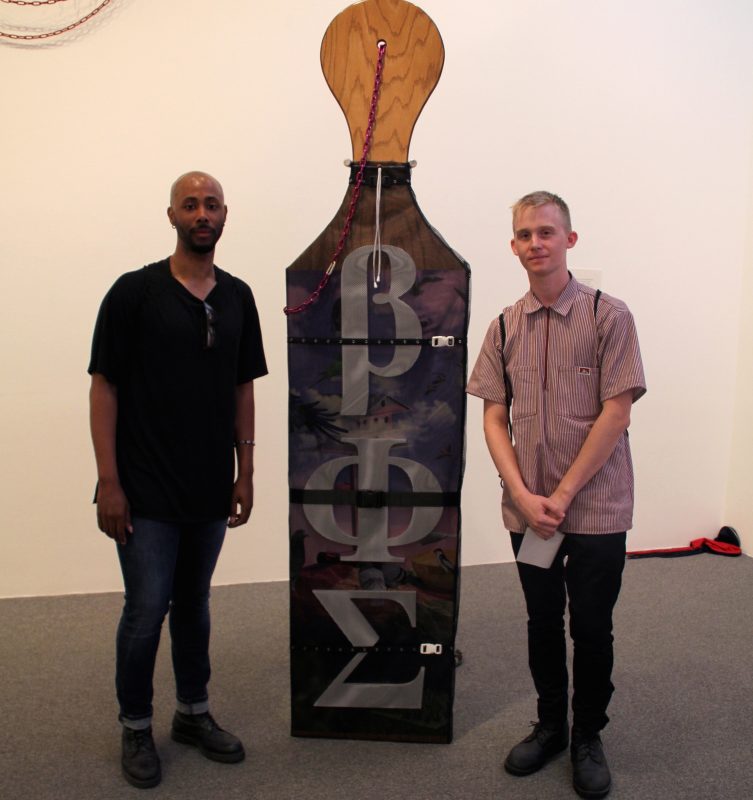
Daniel Wickerham and Malcolm Lomax met as students at MICA, but it wasn’t until after their graduation in 2009 that they began working together as Wickerham & Lomax. Their partnership is obviously a fruitful one. This month, they won the city’s coveted Sondheim Artscape Prize, a $25,000 fellowship, beating out 405 other entries and six other finalists. Their entry—a combination of sculptures and an interactive website that explores inclusion and exclusion of clubs and social networks—is on display at the Baltimore Museum of Art through Aug. 9.
We don’t often hear about art duos. How did you guys decide to work together?
Malcolm Lomax: It’s the one thing that feels really by chance. We didn’t really plan it, and it kind of took root. I got a similar question in a relationship once, where the person said, ‘Why did you choose me?’ You kind of instinctively let it happen, and those are the ones that turn out the best. That’s how we became friends. Mutual interests, but from different vantage points helped grow our practice.
Daniel Wickerham: I’ve become self-conscious about it because I never thought about it until recently. People always ask, ‘How do you share ideas, how do you deal with each other?’ And I was like, ‘Oh, it’s pleasurable, it’s enjoyable, and it’s easy.’ I never really thought about it until people started asking as if it shouldn’t work.
ML: Someone asked me once, ‘What part did Dan make, and what part did you make?’ I think there’s never a point where we don’t talk about [what we’re making] together. The exchange is an integral part of it, so the authorship isn’t as important to us . . . Our practice isn’t about exclusion, it’s about bringing whatever you want to this, and we’ll figure it out somehow. It’s more adaptable than exclusionary. Most people are like, ‘I don’t like this, I don’t think that’s going to work,’ but we usually go, ‘How can this work? How can this be changed?’
How did you both arrive at art?
DW: Malcolm and I have been in the training for it for so long, since we were kids. If there was any doubt, it wasn’t strong enough for us to stop doing it. I didn’t really do anything else besides that growing up.
ML: That’s kind of me, too. No circumstance I’ve ever been in has stopped me from being able to make work . . . It was a way for me to map my thoughts outside my body. It was partly cathartic, but partly, how do I get to the next step? I went to an arts high school.
DW: My last two years of high school were at an art high school. I’m from Columbus, OH.
ML: I’m from South Carolina.
Did you meet at MICA?
DW: We had classes together. We really started hanging out our senior year. Then we graduated and did a show at Open Space gallery. We showed together, but were working separately, and right after that we started doing shows under the name Duo.
ML: Also, we were always the last two people to leave the studio [in college], and that may have been a thing that connected us. We would share things, like I would leave something in your studio, or you would leave something in mine. Then we started emailing and it kind of grew out of that.
What were your areas of emphasis?
ML: Painting.
DW: Yeah, painting. We always joked that at school we were the first class in the painting department to rarely make paintings.
ML: We put paint on things, but we didn’t do paintings.
DW: The class above us was really rigorous about making these taped off, really detailed, thick, sculptural paintings.
ML: And we were like, ‘No more!’
DW: I think the teachers weren’t sure what to do with us. Everyone was making little videos, and sculptures. Right around that time, this small sculpture craze happened in D.C. and New York, and it really influenced a lot of people, so there was a lot of small sculptures being made.
How do you describe your work, particularly your website, to people?
DW: I thought one description of the show worked pretty well, which was, in making the website we were talking about shared bodies and shared roles and locations, and there was something positive about it. And then alongside that was work that was more about exclusion, or how rules get made up to keep people out, or how rules of the community form as a bonding type of thing. So we have these frat paddles with birdhouses on them and we have club fliers, dress codes, and all these different social spaces that have their own rules, and it seemed to be a more sinister version of thinking about communities in the physical world, as compared to the website.
ML: We knew a lot of the forms in the show were loaded, and I was kind of like [is the museum] going to get any weird backlash for this? There’s a consent form that we have to sign that if they want to take something down, it can be taken down. And I was like, ‘We don’t make really polite work.’ But they told us it had never really happened before.
DW: And everything was actually fine.
Did you guys get a good feedback from the show?
ML: We won!
DW: That’s the perfect reception! I was actually there by myself one day while the museum was open, and a lot of people walked by, with someone else, and said, ‘I’ll have to come back,’ like they really wanted to spend time with it. Our work asks for a lot of time, I think, especially the website because you don’t really know what you’re doing . . . I think we like this idea that while people are deciding what they think, keep making more work. You have to trust how you’re navigating your own practice, though feedback is always good.
How do you know when a work is finished?
ML: When we can really feel it being alive.
DW: We know when we’re on the right track with something. Like those busts [in the show], they had these little necklaces with “Believe” on it. It just happened that we had six of these necklaces and six of these busts, and Malcolm said, ‘Let’s just try this.’ We got really excited. It makes the head feel more like a human. And then we thought, well that’s a real reaction, we must be headed in the right direction. I think also you get older and you have more intuition, you just know more what you want to see.
ML: We’re the first viewer so we’re the guinea pig for all of it. That’s the nice thing about having enough time to see the work before the actual show, when the work is pretty far along. But because projects go fast we don’t have as much time to do that, and we’ll talk about all the regrets of the show within a week. We should have done this, this, and this.
DW: This BMA show, we went into it with full vision. We could really see where it was going.
